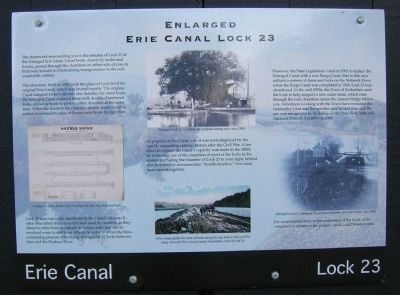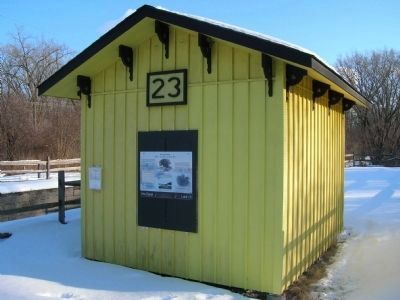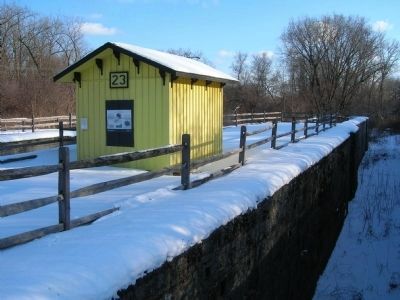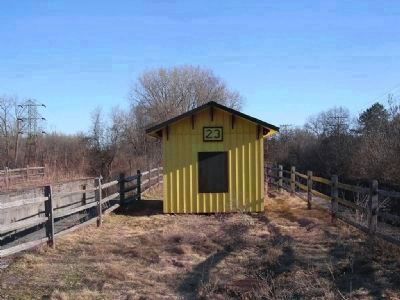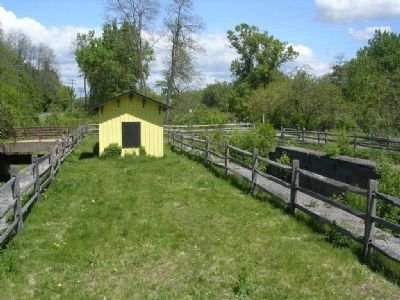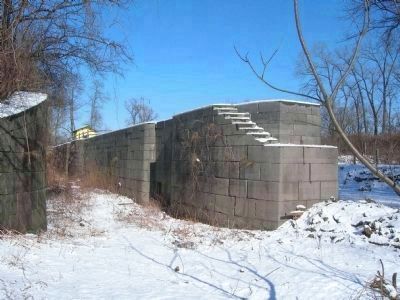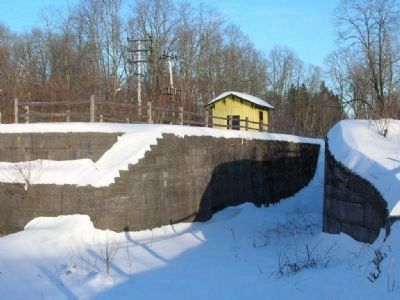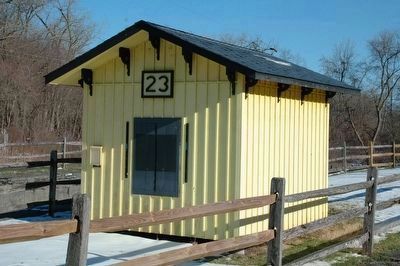Rotterdam in Schenectady County, New York — The American Northeast (Mid-Atlantic)
Enlarged Erie Canal Lock 23
Erie Canal Lock 23
Inscription.
The stonework surrounding you is the remains of lock 23 of the Enlarged Erie Canal. Canal boats, drawn by mules and horses, passed through the chambers on either side of you on their way toward revolutionizing transportation in the mid-nineteenth century.
This structure, built in 1842, took the place of Lock 26 of the original Erie Canal, which was located nearby. The original canal featured locks with only one chamber for canal boats: the Enlarged Canal replaced these with double-chambered locks, allowing boats to pass in either direction at the same time. When the doors to the chamber closed, water could be added or released to raise or lower canal boats by eight feet.
Lock 23 was especially significant in the Canal's history. It often was either the first or last lock used by canalers as they chose to either load or unload in Schenectady and use an overland route to and from Albany in order to avoid the time-consuming process of traveling through the 22 locks between here and the Hudson River.
As popular as the Canal was, it was soon displaced by the rapidly expanding railway system after the Civil War. A last effort to expand the Canal's capacity was made in the 1880s by extending one of the chambers of most of the locks in the system (including the chamber of Lock 23 to your right, behind this structure) to accommodate "double-headers,” two canal boats lashed together.
However, the State Legislature voted in 1903 to replace the Enlarged Canal with a new Barge Canal, that in this area utilized a system of dams and locks on the Mohawk River; when the Barge Canal was completed in 1918, Lock 23 was abandoned. In the mid-1950s, the Town of Rotterdam used the Lock to help support a new water main, which runs through the lock chamber under the cement bridge behind you. Volunteers working with the Town have recreated this locktender's hut and the wooden pier behind you, and the site was recognized by its listing on the New York State and National Historic Registers in 2008.
For more information on the restoration of the Lock, or to volunteer or donate to the project, email [email protected]
Erected 2008 by "Lock 23 Restoration Committee".
Topics and series. This historical marker is listed in these topic lists: Notable Buildings • Notable Places • Waterways & Vessels. In addition, it is included in the Erie Canal series list. A significant historical year for this entry is 1842.
Location. 42° 49.293′ N, 73° 59.232′ W. Marker is in Rotterdam, New York, in Schenectady County. Marker can be reached from Rice Road near Schermerhorn Road. Lock 23 is located beside
the intersection of Rice Road and Schermerhorn Road in Rotterdam, New York.
The Mohawk-Hudson Bike Trail is built on the old towpath and passes right beside the lock.
The Marker is mounted on the Lock Tender's Hut which stands on the island between the two lock chambers. Touch for map. Marker is at or near this postal address: 40-60 Rice Rd, Schenectady NY 12306, United States of America. Touch for directions.
Other nearby markers. At least 8 other markers are within 2 miles of this marker, measured as the crow flies. Enlarged Lock 23 (within shouting distance of this marker); Bradt House (approx. ¼ mile away); The Movable Dam at Lock 8 (approx. half a mile away); Robert Allen Deitcher (approx. 0.7 miles away); Maalwyck (approx. 0.8 miles away); Vedder Family Cemetery (approx. 0.9 miles away); The Camp (approx. 1.2 miles away); In Commemoration (approx. 1.4 miles away). Touch for a list and map of all markers in Rotterdam.
Regarding Enlarged Erie Canal Lock 23. Enlarged Double Lock No. 23, "Alexander's Lock", was constructed to replace nearby Lock 26, one of 83 "first generation" locks originally built as part of Clinton's Ditch. The overnight success of the Erie Canal proved a mixed blessing. By the end of the first decade of operation the heavy volume of canal traffic was taxing the original system beyond its designed capacity. Single chamber locks quickly proved inadequate as lines of boats waiting to pass formed in both directions.
Beginning in 1836 the Canal Commissioners of the State of New York initiated a comprehensive program of system improvements, carried out in stages between 1836 and 1862, which reduced the number of locks from 83 to 72 and doubled their capacity by adding a second chamber at each site in order to allow two-way traffic.
Lock No. 23 was constructed in a double-chamber configuration during this period of the First Enlargement in 1840-1841 and opening to traffic in 1842. Rather than expand the existing Lock 26, as was done at several other locations, a completely new double-chambered lock was built immediately adjacent to the original lock and right-of-way. Lock chambers were built wider and longer, at 18 feet wide by 110 feet in length. Previously they were 15 feet wide by 90 feet long.
Built entirely of large cut limestone blocks laid in a regular ashlar pattern and mortared using hydraulic cement, Lock No.23 raised or lowered boats by 7.89 feet; from a level of 231 feet at the south end to 239 feet at the north end. This lock was of importance to the Erie Canal, and Schenectady, N.Y. in particular, because it was the first lock west of Schenectady, a.k.a., "Gateway to the West", a major transfer point at the west end of the 17-mile portage from Albany around the Cohoes Falls. Many passengers left the Erie Canal to travel overland between Albany and Schenectady;
goods stayed on barges for the trip which could take more than a day. During its busiest seasons, the lock was operating with a lockage every 5 minutes. (Approximately 47,000 lockages per season).
By the last quarter of the nineteenth century, the Canal Commissioners recognized that the Erie Canal would require substantial further modification if it was to remain competitive with expanding rail transportation. During the early 1880s, steam motive power introduced on the Eric Canal led to the introduction of larger vessels that could be towed or pushed in combination along the waterway. To accommodate this traffic, a program to lengthen the locks was begun in 1884. Lock No 23 was one of six locks lengthened during 1889. The southwest chamber was extended south to a total of 220 feet along the berm side; the width of the added portion of the lock chamber was 20 feet. With its southwest chamber nearly doubled in size, Lock No. 23 could raise or lower "double-header" vessels towed by steam barges without interrupting though traffic.
With the opening of the current Barge Canal the Enlarged Canal was abandoned in 1918, and this section of the canal was purchased by the General Electric Company (GE). GE kept water in the canal from their main plant in Schenectady to Lock 23 until the late 1950's. It functioned as a test bed for GE products including the Electric Mules
used to pull ships through the locks in the Panama Canal. In the 1950s, the lock property was donated to the Town of Rotterdam which was in the midst of building its new water pumping station on the nearby well field; the town ran its new main directly through the lock chambers. Portions of the limestone walls were partially collapsed to make way for the pipe. In the north chamber the pipe was covered with debris and dirt blocking off that chamber. In the south chamber the cement replaced the removed limestone blocks and a concrete walkway was installed above the waterway crossing the chamber, however the water main is no longer in use.
After a long period of neglect, the lock had become completely overgrown. Beginning in 1999, students and staff of the Department of Civil Engineering at Union College had undertaken an effort to keep the lock free from small trees and brush and at one time had an ambitious plan to rehabilitate the lock and bring it back to working condition. Between 2000 and 2003 they built a replica board-and-batten Lock Tender's Hut and a Wooden Pier. Volunteers from Union College History Department were joined by volunteers from the Schenectady County Historical Society, the Rotterdam Sunrise Rotary Club and Friends of the Mohawk-Hudson Bike-Hike Trail in subsequent years to maintain the lock and continue promoting its preservation and sought official
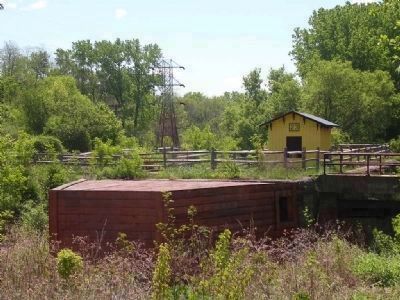
Photographed By Howard C. Ohlhous, May 21, 2005
6. Enlarged Erie Canal Lock 23
Lock Tender's Hut & Wooden Pier
Lock Tender's Hut & Wooden Pier
Between 2000 and 2003 students and staff of the Department of Civil Engineering at Union College, working with the Town of Rotterdam, built the replica board-and-batten Lock Tender's Hut and a Wooden Pier, in the foreground, at Lock 23.
On December 28, 2007 the New York State Office of Parks, Recreation and Historic Preservation listed the Lock No. 23 property on New York’s registry as an important engineering landmark in Schenectady County. On March 6, 2008 Lock No. 23 had been listed on the National Register of Historic Places. Plans are in the works to apply for grant monies and the installation of permanent interpretive signs about the lock.
Lock No. 23 remains the focus of continuing preservation efforts and a distinguished example of masonry engineering design and construction associated with the transportation history of the Old Erie Canal.
Also see . . . "Making It Work - The Pier". This webpage explains the function of the wooden pier of the type recreated at Lock 23. (Submitted on November 29, 2009, by Howard C. Ohlhous of Duanesburg, New York.)
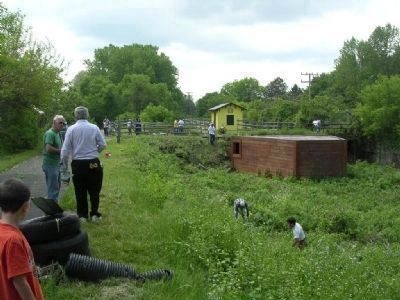
Photographed By Howard C. Ohlhous, May 27, 2005
7. Clean Up Day at Lock 23
Professor Andrew Morris of the Union College Department of History organized the "Lock 23 Clean Up Day" held on May 27, 2005. Here we see Union College students as well as other volunteers cutting back brush and removing debris from the lock. At this location the Mohawk-Hudson Bike-Hike Trail is built on the old tow path and passes right beside the lock, on the left, in this view.
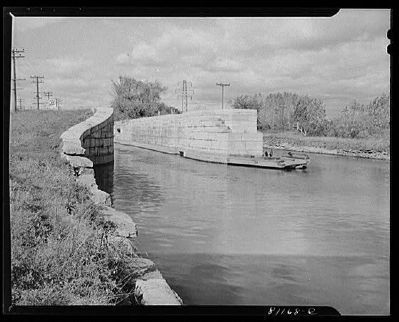
Photographed By John Collier, Oct. 1941
8. Enlarged Erie Canal Lock 23 in 1941
Lock 23 in 1941 showing the southern end of the west lock chamber. In this photo the water is still in the canal as it is being used by Schenectady's General Electric for testing. The wooden pier is still quite evident in the water at the foot of the lock. ""Lock on the old Erie Canal not in use, New York" / John Collier, photographer -- Farm Security Administration-Office of War Information Photograph Collection, Library of Congress Prints & Photographs Division, Oct. 1941 "
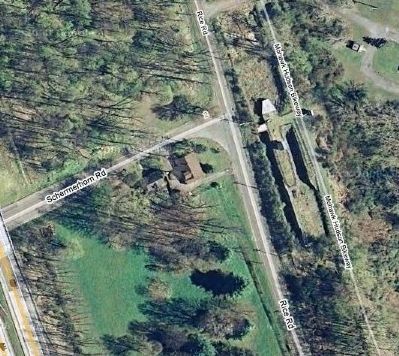
Photographed By Google Maps
11. Enlarged Erie Canal Lock 23
The Erie Canal had many bends and curves in order to fit the contours of the land. In this aerial view of Lock 23 the canal is in an almost north-south configuration. Following the canal south here would take a canawler first to Schenectady, and eventually to Albany on the Hudson River. Going north here would be Canal West; toward Amsterdam, and on to Buffalo and Lake Erie.
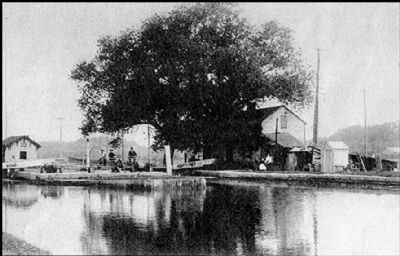
Schenectady County Historical Society
12. Enlarged Erie Canal Lock 23 Marker Detail
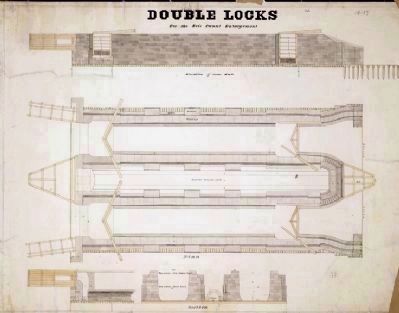
New York State Archives
13. Enlarged Erie Canal Lock 23 Marker - Double Lock Detail
Double Locks for the Erie Canal Enlargement, c.1840 ink and watercolor on paper, 23 1/4 x 29 3/4 in.
Courtesy of New York State Archives
The pier that the Union College Students built at Lock 23 is similar to the one on the left in this drawing.
Credits. This page was last revised on June 16, 2016. It was originally submitted on November 28, 2009, by Howard C. Ohlhous of Duanesburg, New York. This page has been viewed 3,843 times since then and 63 times this year. Last updated on December 4, 2009, by Frank E. Sadowski Jr. of Fairport, New York. Photos: 1, 2, 3, 4, 5, 6, 7, 8, 9, 10, 11, 12, 13. submitted on November 28, 2009, by Howard C. Ohlhous of Duanesburg, New York. 14. submitted on April 8, 2016, by Howard C. Ohlhous of Duanesburg, New York. • Kevin W. was the editor who published this page.
